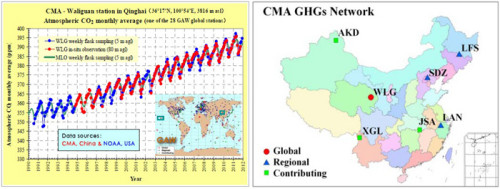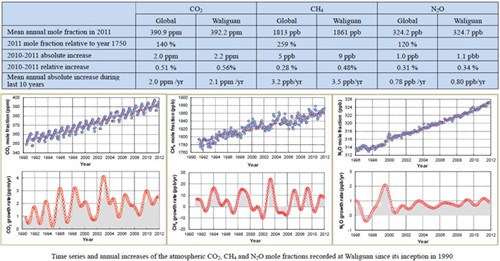

On January 14, 2012, China Meteorological Administration (CMA) released the No.1 issue of China Greenhouse Gas Bulletin, which is made by the Climate Change Centre of CMA.
Since 1980s, China Meteorological Administration (CMA) has put in place seven atmospheric background stations-Waliguan in Qinghai (WLG), Shangdianzi in Beijing (SDZ), Lin'an in Zhejiang (LAN), Longfengshan in Heilongjiang (LFS), Shangri-La in Yunnan (XGL), Jinsha in Hubei (JSA) and Akedala in Xinjiang (AKD), which represent a number of typical climatic, ecological and economic zones in China. Greenhouse gases and related tracers have been observed by network stations in a standard and consistent routine in response to the Kyoto Protocol and the Montreal Protocols. In particular, the Waliguan Global Atmosphere Watch Baseline Observatory has engaged in flask air sampling analysis since 1990 and in-situ observation since 1994. The 20-year history in observation rewards the longest time series in atmospheric CO2 records in China. The flask air sampling analysis and the in-situ observations were launched in other background stations beginning from 2006.
Executive Summary
The World Meteorological Organization (WMO) Greenhouse Gas Bulletin (2011) No. 8 released by WMO on 19 November 2012 shows that globally averaged mole fractions in atmospheric carbon dioxide (CO2), methane (CH4) and nitrous oxide (N2O) continued to hit new highs in 2011, with CO2 at 390.9 ± 0.1 ppm, CH4 at 1813 ± 2 ppb and N2O at 324.2 ± 0.1ppb. These values constitute 140%, 259% and 120% of pre-industrial (before 1750) levels.
As analyzed from observational data at the seven China Meteorological Administration (CMA) background stations through 2011, averaged mole fractions in atmospheric CO2, CH4 and N2O also hit new highs in 2011, with the Waliguan station in Qinghai registering 392.2 ppm for CO2, 1861 ppb for CH4 and 324.7 ppb for N2O. As a record high since the observation was started in 1990, they are roughly equivalent to the averaged mole fractions in the northern mid-latitudes, but are slightly higher than the global averages in all these components (390.9 ppm, 1813 ppb and 324.2 ppb) over the same period. Global mole fractions in atmospheric CO2, CH4 and N2O increased by 2.0 ppm, 5 ppb and 1.0 ppb in absolute terms, from 2010 to 2011, while those at Waliguan by 2.2 ppm, 9 ppb and 1.1 ppb. Global annual averages in atmospheric CO2, CH4 and N2O over the past 10 years increased by 2.0 ppm, 3.2 ppb and 0.78 ppb in absolute terms, while those at Waliguan 2.1 ppm, 3.5 ppb and 0.80 ppb.
As observed by the three regional stations of Longfengshan in Heilongjiang, Shangdianzi in Beijing and Lin'an in Zhejiang in 2011, the annually averaged mole fractions in atmospheric CO2 were 395.8 ppm, 393.3 ppm and 400.8 ppm, those in CH4 1942 ppb, 1887 ppb and 1942 ppb, and those in N2O 325.5 ppb, 324.8 ppb and 326.0 ppb, all being higher than the observations made at Waliguan (392.2 ppm, 1861 ppb and 324.7 ppb) over the same period. This is somewhat a reflection of the anthropogenic impacts more active in and around the three regional background stations.
The atmospheric SF6 mole fractions observed at Waliguan and Shangdianzi reached 7.54 ppt and 7.52 ppt in 2011, - the highest ever records since the observation was launched at the two sites.
Overview
The World Meteorological Organization's Global Atmosphere Watch (WMO/GAW) Programme coordinates the systematic observation and analysis of greenhouse gases (GHGs) and other trace species. Through the end of 2011, it enlists 28 global background stations, 410 regional background stations and over 80 contributing stations. However, these stations, which are sparsely and unevenly distributed, are mostly situated in developed countries and regions and rarely in the inland Asia. Four (Waliguan, Shangdianzi, Lin'an and Longfengshan) out of the seven atmospheric background stations established and operated by CMA in a number of typical climatic zones in China have been listed in the WMO/GAW directory. At the same time, the system of GHGs observation, analysis and calibration has been developed in line with the international framework. Part of the observations by Waliguan and Shangdianzi are accessible to the World Data Centre for Greenhouse Gases (WDCGG) and the global database. The data was widely cited in the WMO GHGs Bulletins, relevant publications and scientific assessments.
The following table provides annually averaged mole fractions of the three major long-lived GHGs as recorded at global level and at Waliguan, China in 2011, and changes in these mole fractions since 2010 and 1750. The results are obtained from analysis of observational datasets that are traceable to the WMO World Reference standards. (Jan. 14)
(Source: Climate Change Centre, CMA/China Meteorological News Press)

Copyright ©1999-2011 Chinanews.com. All rights reserved.
Reproduction in whole or in part without permission is prohibited.